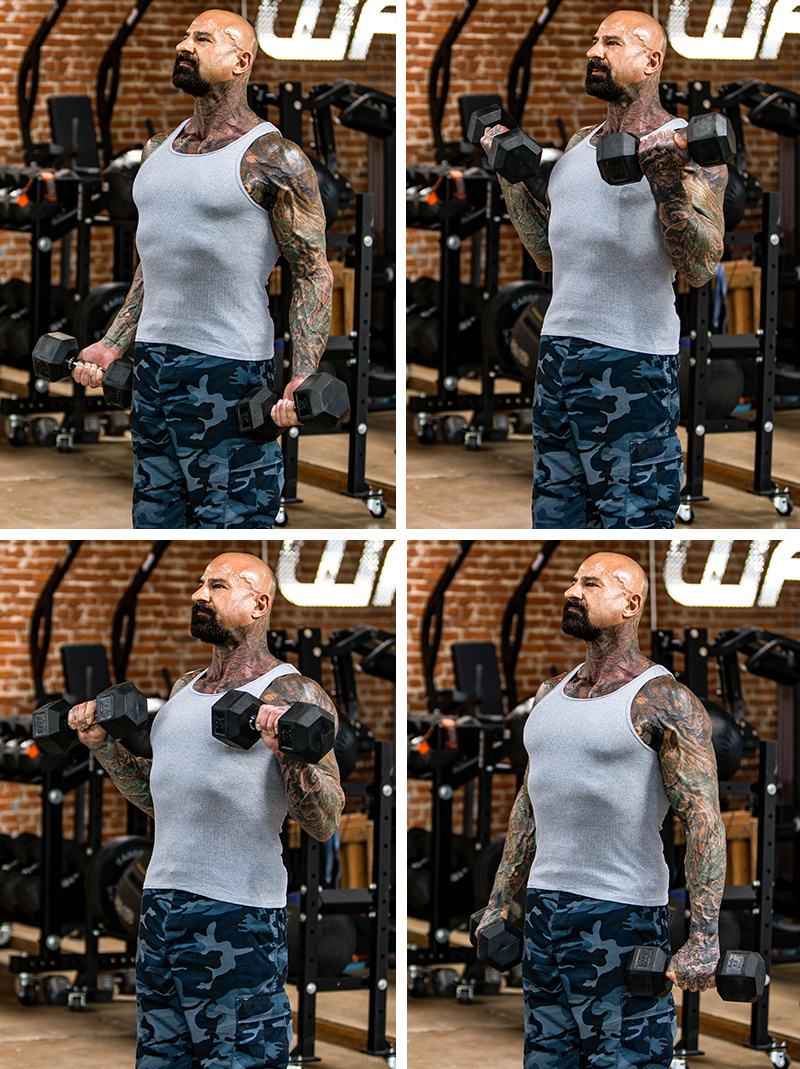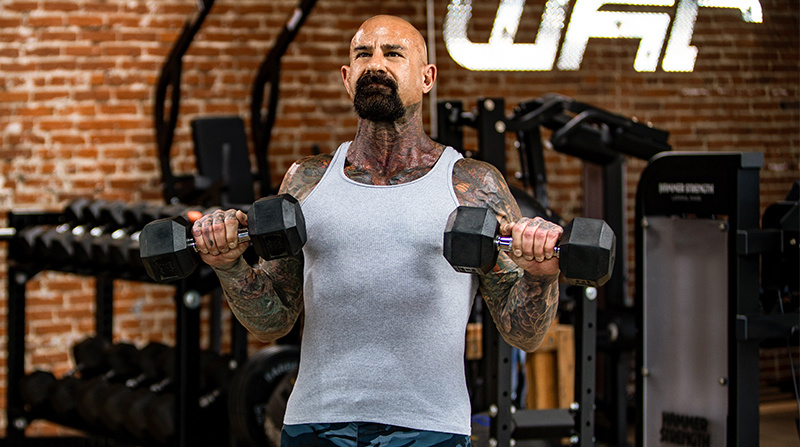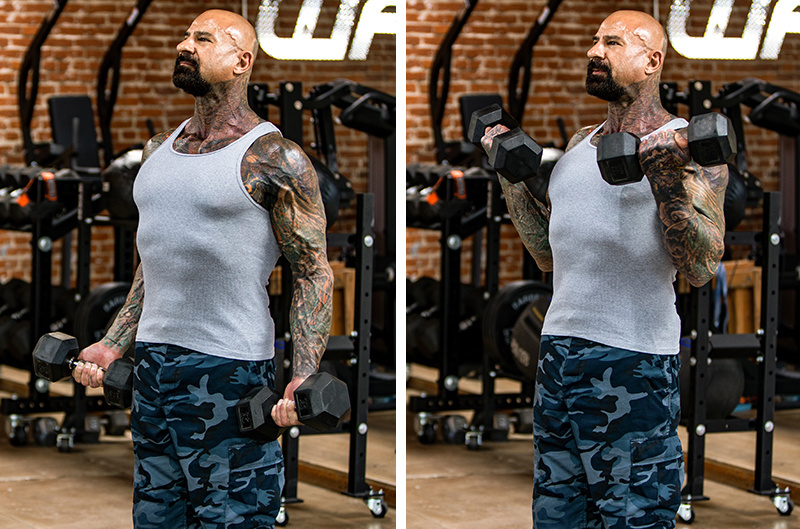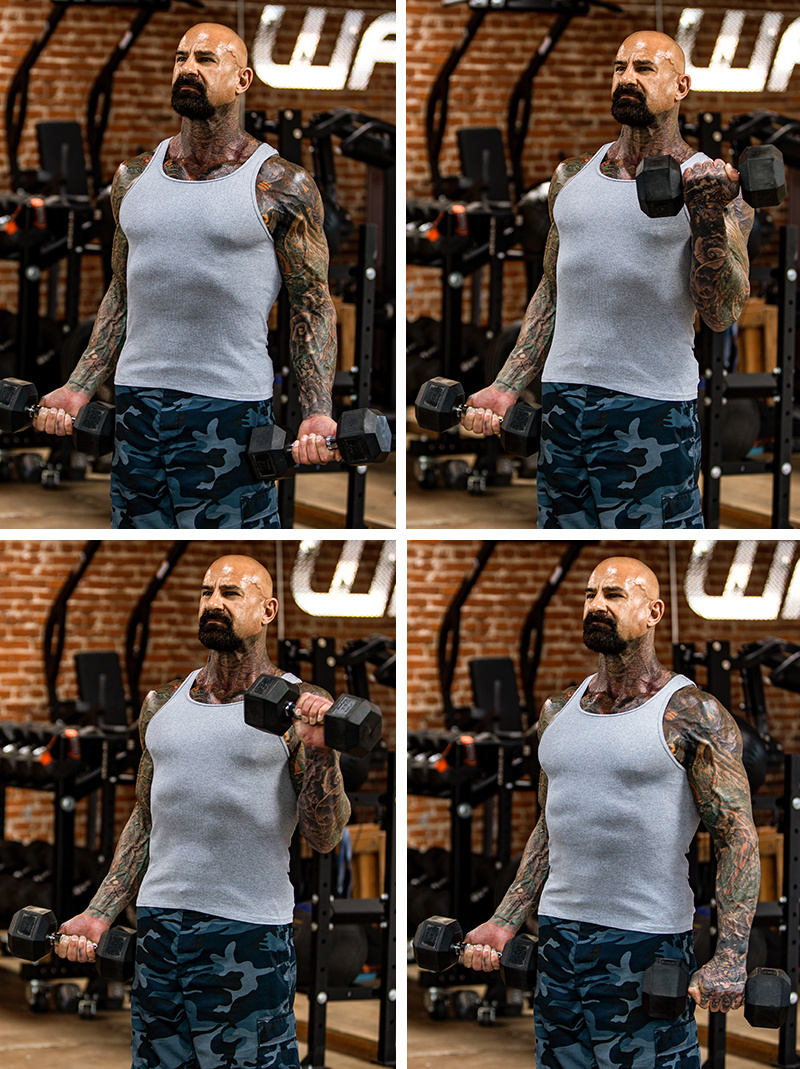Zottman Curl Master Class
Hit your biceps and forearms with one great bang-the-buck arm exercise.

Hit your biceps and forearms with one great bang-the-buck arm exercise.

If you want a truly impressive pair of pipes, it takes more than just well-developed biceps and triceps. Forearms are a key muscle group for a complete physique, not to mention functional grip strength.
Yet for some reason, the forearms are often trained half-heartedly at the end of an arm workout – or worse, ignored altogether. Don’t do that!
I think I know one reason why the forearms commonly take a backseat: People don’t want to take the time to train another bodypart in their workout, especially a relatively small one.
I firmly believe in allotting time to do isolated forearm work, but if you’re looking for a “shortcut,” there’s one exercise that sufficiently hits both the biceps and forearms: the Zottman Curl.
What is the Zottman Curl? It’s half standard (supinated) dumbbell curl, half reverse (pronated) curl. The supinated curl on the way up targets the biceps, and the controlled negative in the pronated position overloads the forearms for maximal development.
Insert this move into your regular biceps training if you’re looking for a great “bang for your buck” biceps/forearms exercise.
Like the Arnold Press and Scott Curl, the Zottman Curl is a unique variation of a traditional exercise named after a physique legend. George Zottman was a prominent strongman athlete from Philadelphia in the late 1800s and early 1900s. Though he died in 1942, his namesake exercise lives nearly 80 years later.
With limited historical accounts, it’s hard to say definitively if he actually invented the exercise, but it’s easy to see why it was named after him: At a solid 5’11”, 218 pounds, he had 19-inch (upper) arms and 15-inch forearms. Most 5’11” guys don’t have 15-inch upper arms, let alone forearms! His measurements were even more impressive in the 1800s, before exercise science was even a thing. He was even nicknamed “Hercules”!

There are three major muscles targeted with the Zottman Curl: biceps brachii, brachialis, and brachioradialis.
On the positive portion of each rep (supinated forearms), the biceps brachii is the primary muscle involved. On the negative (pronated forearms), the brachialis and brachioradialis take the brunt of the load.
As I mentioned above, Zottman Curls are great for developing both the biceps and forearms. Where the biceps are concerned, the exercise is effective in essentially the same way as a standard dumbbell curl where the forearms remain in the supinated position (palms forward/up) throughout.
The negative portion, which focuses on the forearms, is what really distinguishes the Zottman Curl. But it’s not just that the forearms are targeted – it’s that they’re overloaded to a greater extent than on standard reverse curls where the forearms are pronated the entire time.
The reason for this is simple: With the forearms supinated, you’re in a biomechanically stronger position to curl. That’s why you’re always able to use more weight on standard curls versus reverse curls. With the Zottman Curl, doing supinated curls on the way up allows you to use more weight than you’d normally use for reverse curls, thus making for a heavier negative rep and greater overload on the forearms.
In this way, the Zottman Curl is more of a forearm-focused move. Yet you’re still getting the same overload on the biceps on the positive portion of the rep as you would with a standard dumbbell curl.
This is really a two-part exercise. On the way up, it’s all about the biceps; on the way down, you’re focusing on the forearms. (Of course, the forearms are also involved on the positive, as are the biceps on the negative – just to lesser degrees.)
Don’t assume that the biceps are getting worked more than the forearms on Zottman Curls just because they’re getting the positive portion of each rep. When the weight is lowered under total control, the negative portion of the rep provides a unique shock to your muscles that’s extremely effective for getting bigger and stronger.
Most people disregard the eccentric (negative) portion of the rep, thinking that the muscle is only working when you’re lifting the weight, not lowering it. Not true. Resisting the weight on the negative is a crucial aspect of strength and is actually the part of the movement most closely associated with muscle soreness in the days following a workout. That soreness will eventually lead to more size and strength, assuming the muscles get a full recovery through nutrition and rest.

Don’t go too heavy on Zottman Curls. I recommend using dumbbells that allow for 10-15 reps of standard (supinated) curls.
Going too heavy will make it difficult to control the weight on the negative in the reverse grip (pronated) position. You don’t want the weight to drop fast on the way down. That would defeat the purpose of the exercise. The negative should be nice and controlled, and this requires a more moderate load.
One great technique for maximizing intensity on a given set is to finish your Zottman Curls off with standard curls. Why? Because as I said above, the negative portion of the rep on Zottman Curls is heavier than your forearms are accustomed to on reverse curls. As a result, your muscles will get fatigued by the heavier negatives and will eventually give out.
When this happens, don’t end the set – just finish it with standard dumbbell curls where you don’t pronate the forearms/wrists at the top of the rep. Doing the negatives in the supinated position will allow you squeeze out a few more reps. You’re essentially training past failure when you do this, which boosts intensity for more muscle and strength.

For example, you may do 10 reps of Zottman Curls, find you’re not able to lower the negative under control, then immediately switch to standard curls mid-set and do 2-3 more reps.
I normally prescribe Zottman Curls to be done both arms at a time, but you can also do them one arm at a time to focus on each arm individually. If you choose this route, alternate arms every other rep just like you would with alternating dumbbell curls.
The technique remains the same with this variation: curl the right arm up with forearm supinated (palm facing forward), pronate the forearm at the top and lower the negative under control, then repeat with the left arm. That’s one rep.

Zottman Curls can be programmed into your arm workout in one of two ways: either at the end of your biceps workout or as a segue exercise to forearm work.
The Zottman Curl is a classic “transition” exercise. It’s a biceps move, but it’s also a forearm move. If you’re training biceps without forearms, do Zottman Curls last to get a bit of forearms stimulus while still hitting the biceps sufficiently. If you’re doing both biceps and forearms (one after the other), do Zottman Curls after your last true biceps exercise and before your first isolated forearm move.
Here’s a sample biceps/forearms workout using the Zottman Curl as a “bridge” exercise:
| Exercise | Sets | Reps |
|---|---|---|
| Barbell Curl | 3 | 8-10 |
| Incline Dumbbell Curl | 3 | 6-8* |
| EZ-Bar Preacher Curl | 3 | 10-12** |
| Zottman Curl | 3 | 8-10*** |
| Reverse Curl | 2 | 10-12 |
| Seated Dumbbell Wrist Curl | 2 | 15** |
*Do 1-2 rest-pauses on last set.
**Do 1-2 drop sets on last set.
***On your last set, after reaching failure, finish with standard supinated curls until reaching failure again.
Related Articles